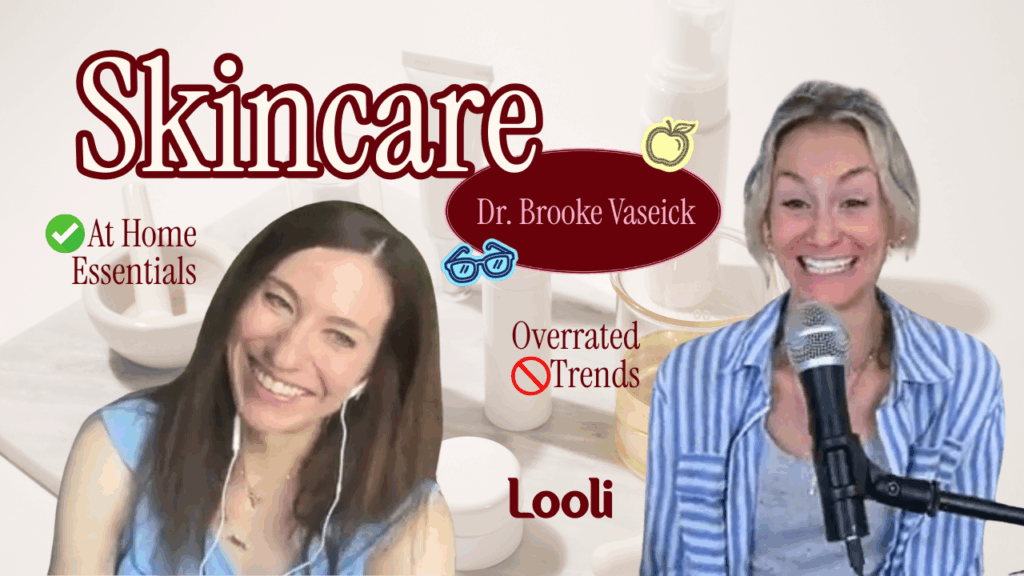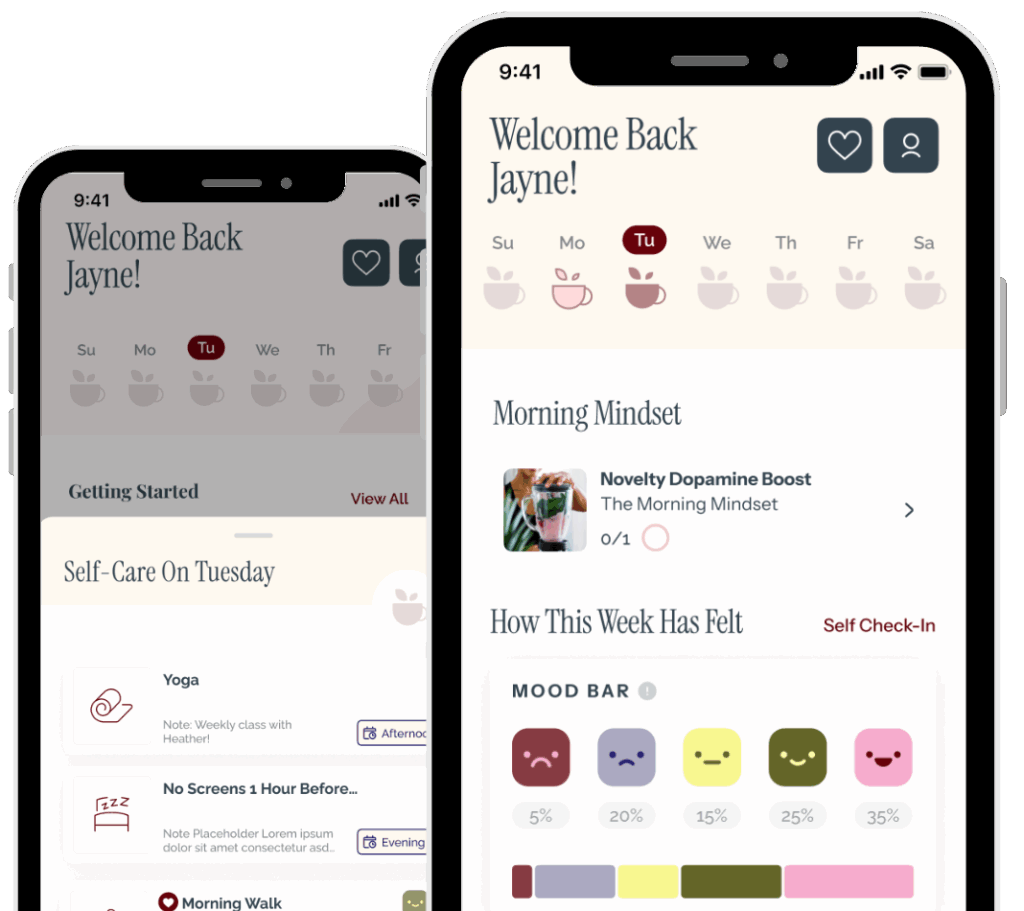At-Home DIY to Injectables: Your Guide to “Anti-Aging” Skincare
Watch:

Listen:
Aging gracefully isn’t about chasing perfection — it’s about giving your skin the care it needs to look and feel its best. Whether you’re just starting your skincare journey at home or considering professional treatments, knowing where to begin can feel overwhelming.
We sat down with Dr. Brooke Vasicek, Board-certified dermatologist and Fellow of the American Academy of Dermatology, to get the lowdown on what actually works — and what’s more hype than help.
This guide breaks it all down into three clear sections: what to do at home, what professionals can offer, and the myths and must-dos that every skincare lover should know. By the end, you’ll have a roadmap to approach skincare with confidence and clarity.
At-Home Skincare
“What’s worth doing on your own?”
Before booking a dermatologist appointment, there’s a lot you can do at home to maintain healthy, vibrant skin. Dr. Vasicek recommends starting with a strong foundation and building from there.
1. Cleanser (AM + PM)
- Recommended products: CeraVe Hydrating Cleanser (dry skin) or La Roche-Posay Toleriane Purifying Foaming Cleanser (oily/combination)
- Cleansing removes dirt, oil, and pollutants. Gentle cleansers preserve your skin barrier while keeping it clean. Avoid harsh scrubs or over-cleansing, which can accelerate aging.
2. Antioxidants (Vitamin C, AM)
- Recommended products: SkinCeuticals C E Ferulic or Obagi 20% Vitamin C Serum
- Protects against free radicals and environmental damage, brightens skin, and supports collagen health. Apply after cleansing, before moisturizer.
“The best quality vitamin C is going to have vitamin E in it as well, or an added topical ingredient called ferulic acid. Vitamin C that is stabilized with E and ferulic acid will be more beneficial. Generally something 15 to 20 percent.” – Dr. Vaseick
3. Eye Cream (AM + PM)
- Recommended Products: NeoCutis Firm Riche, Obagi Elastiderm
- The eyes can be a hard place to reverse aging due to the skin around the eyes is so thin and they’re very dynamic muscles, losing water more rapidly.
“An eye cream is something that I usually tell everyone they should probably have in their regimen. Otherwise, just make sure your retinol’s getting up there.” – Dr. Vaseick
4. Moisturizer (AM + PM)
- Recommended products: Neutrogena Hydro Boost Gel or Cream (Gel for more oily skin, cream for more dry),
- Hydration is key to maintaining a strong skin barrier. Locks in water and active ingredients. Choose based on skin type (lightweight for oily, richer for dry).
- Hyaluronic acid is an ingredient you can look for that draws in water and is a humectant to help with plumping and fine line.
- Other ingredients to consider:
- Niacinamide is vitamin B3 which is good for anti-aging and oxidation.
- Isonimide can be another effective anti-aging ingredient.
- Peptides can be a part of an anti-aging regimen but they’re also hundreds of dollars. Dr. Vaseick says “For me the data is not there yet to ask people to spend their hard-earned two to three hundred dollars on these.”
5. Sunscreen (AM, daily)
- Recommended products: Tizot Tinted Sunscreen, Color Science Sunscreens, Isdin Sunscreen
- Non-negotiable. Prevents sun damage, wrinkles, and skin cancer. Apply every day, even indoors.
6. Retinol / Retinoids (PM)
- Recommended products: Prescription Retin-A (tretinoin)
- Supports cell turnover, reduces fine lines, improves texture and tone. Start slowly (1–2x per week) and gradually increase.
Order of importance:
Cleanser → Moisturizer & Sunscreen → Add Vitamin C once basic routine is comfortable → Introduce Retinol slowly into PM routine → Eye cream
Budget note: Effective ingredients matter more than price; luxury brands are not required.
When to seek help: If you’ve been consistent for 8–12 weeks without seeing improvement, consider professional care.
Dermatologist Treatments
“Here’s what a pro can do that your skincare routine can’t”
Even the best at-home routine has its limits. Certain treatments can accelerate results, target deeper concerns, and support collagen and tissue remodeling in ways topical products cannot. Dr. Vasicek recommends a tiered approach, starting with less invasive options.
Microdermabrasion
A gentle, non-invasive treatment that uses a suction tool to remove dead skin cells and resurface the skin. A great beginner treatment — minimal downtime, affordable, and gives an instant “fresh-faced” glow.
- Brightens and freshens the skin
- Promotes a dewy, smooth look
- Helps with general skin tone and texture
- Often sold in packages of 3–6 sessions for best results
- Maintenance can be done once or twice per year
Price range:
💰 Low hundreds (per package)
Chemical Peels
A topical treatment that uses acids to exfoliate and renew the skin’s surface. Chemical peels can range from very gentle to quite strong.
- Treats acne, fine lines, and dark spots
- Improves overall skin tone and texture
- Mild “weekend” peels: no visible peeling or just light flaking for 2–3 days
- Stronger peels: visible peeling and several days of downtime
- Usually a series of 3–6 treatments spaced a few weeks apart
- Consultation recommended to match peel strength to your skin type and goals
Price range:
💰Low hundreds (for a package of three)
Microneedling
A treatment that uses a pen with tiny needles to create micro-injuries, stimulating collagen and elastin production. Dr. Vaseick’s personal favorite!
- Improves fine lines, wrinkles, skin texture, and elasticity
- May help with pore size and pigmentation
- Topical numbing is used
- Downtime is minimal — mild redness for 1–2 days (“like a light sunburn”)
- You can return to normal activities the next day
- 3 sessions spaced 4–6 weeks apart
- Maintenance every 3–6 months or annually
Price range:
💰 Mid to high hundreds (for a package of three)
Laser & Light Treatments
High-intensity light or laser-based treatments that target pigmentation, redness, or texture. There are many types of lasers, so a consultation is key. These are more advanced and usually done after other treatments.
- IPL/BBL: Treats brown spots and redness (like sun freckles or rosacea)
- Vascular lasers: Target redness and visible blood vessels
- Resurfacing lasers: Use light or radiofrequency to tighten and rejuvenate skin
- Reduce sun damage, redness, and uneven tone
- Stimulate collagen and tighten skin
Price range:
💰 Thousands (for a series of three treatments)
Injectables
- Neuromodulators (Botox, Dysport, Xeomin, Jeuveau): Relax facial muscles to prevent deepening of wrinkles caused by movement (like frowning or raising brows). Softens lines and prevents new ones from forming.
- Botox won’t erase wrinkles completely but prevents them from deepening over time.
- Commonly repeated every 3–4 months
- Fillers: Add volume to areas that have lost fullness, restore structure.
- Kybella: Dissolves fat under the chin (“double chin” area). Reduces submental fat.
Price range:
💰 Varies by product and area (typically mid to high hundreds per session)
Myths, Mistakes & Must-Dos
Common Myths
- Sunscreen causes cancer: False. Sunscreen protects against DNA damage that leads to skin cancer.
- Natural ingredients are always safer: False. “Natural” doesn’t guarantee effectiveness or safety.
- Creams can shrink pores: False. Pores don’t shrink, but appearance can improve with proper care.
Common Mistakes
- Sleeping face-down
- Drinking through straws (lip lines)
- Over-exfoliating
Must-Dos
- Wear sunscreen daily
- Consider oral vitamin D supplementation
- Appreciate aging — skincare is care, not erasing your story
Bottom Line
Great skin is about consistency, smart choices, and understanding your options. Start with a solid at-home routine, know when professional treatments can help, and remember: aging gracefully is a privilege to celebrate.
“Your skin tells a story — the goal isn’t erasing it, it’s writing it well.” — Dr. Brooke Vasicek

Download The Looli App
Make your wellness a priority, inside and out!
Start your free 7 day trial and access more tools, resources, recipes, workouts and more.

